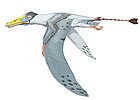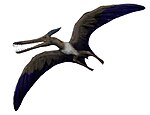Istiodactylidae
| Istiodactylids Temporal range: Early Cretaceous, Possible Middle Jurassic record
| |
|---|---|

| |
| Life restoration of Istiodactylus latidens feeding on a stegosaur corpse. | |
| Scientific classification | |
| Domain: | Eukaryota |
| Kingdom: | Animalia |
| Phylum: | Chordata |
| Order: | †Pterosauria |
| Suborder: | †Pterodactyloidea |
| Clade: | †Lanceodontia |
| Clade: | †Istiodactyliformes |
| Family: | †Istiodactylidae Howse, Milner & Martill, 2001 |
| Type species | |
| †Ornithodesmus latidens Hooley, 1913
| |
| Genera | |
| |
Istiodactylidae is a small family of pterosaurs. This family was named in 2001 after the type genus Istiodactylus was discovered not to be a member of the genus Ornithodesmus.
Systematics and distribution
[edit]
Remains of taxa that can be confidently assigned to Istiodactylidae have been found in the UK and China, in rocks dating from the Early Cretaceous period (Barremian to Aptian stage).[2] Arbour and Currie (2011) described Canadian Gwawinapterus beardi as a member of Istiodactylidae living in the late Cretaceous (upper Campanian stage);[3] however, Witton (2012) suggested the tooth replacement pattern in this animal does not match that of pterosaurs, suggesting that the species might be non-pterosaurian.[2] Additional research suggested that the species was in fact a fish.[4] The earliest known species might be Archaeoistiodactylus linglongtaensis, from the Middle Jurassic of China;[5] however, it also has been suggested that the holotype specimen of this species might actually be a poorly preserved specimen of Darwinopterus.[6] Hongshanopterus, a supposed istiodactylid from China, has been reclassified as a non-istiodactylid member of Ornithocheiroidea of uncertain phylogenetic placement by Witton (2012).[2]
Istiodactylids were medium-sized pterosaurs with flat, rounded jaws similar to that of a duck. They had small teeth lining their jaws, however, and this can mostly be seen in the more advanced genera such as Istiodactylus.[7]
Classification
[edit]
Below is a cladogram showing the phylogenetic placement of this group within Pteranodontia from Andres and Myers (2013).[8]
| Pteranodontia |
| ||||||||||||||||||||||||||||||||||||||||||||||||
The cladogram below is a topology recovered by Kellner et al. (2019). In the analyses, they recovered Istiodactylidae within the more inclusive group Istiodactyliformes, and assigned both Istiodactylus and Liaoxipterus to a new subfamily called Istiodactylinae, but kept Nurhachius as a basal member.[9]
| Istiodactyliformes |
| ||||||||||||||||||
Paleobiology
[edit]Lifestyle
[edit]Unlike most ornithocheiroids, istiodactylids bear physiologies suited to a terrestrial life and many of their fossils have been found in freshwater-deposits. Istiodactylids are considered to be pterosaurian equivalents to vultures: acting as the clean-up crew in their native locations. Whether or not istiodactylids could swim like most water-loving pterosaurs remains a mystery.
References
[edit]- ^ Hone, David W. E., Fitch, Adam J., Ma, Feimin, and Xu, Xing. 2020. An unusual new genus of istiodactylid pterosaur from China based on a near complete specimen. Palaeontologia Electronica 23(1):a09. https://doi.org/10.26879/1015 palaeo-electronica.org/content/2020/2931-a-new-istiodactylid-pterosaur
- ^ a b c Mark P. Witton (2012). "New Insights into the Skull of Istiodactylus latidens (Ornithocheiroidea, Pterodactyloidea)". PLOS ONE. 7 (3): e33170. Bibcode:2012PLoSO...733170W. doi:10.1371/journal.pone.0033170. PMC 3310040. PMID 22470442.
- ^ Arbour V.M.; Currie P.J. (2011). "An istiodactylid pterosaur from the Upper Cretaceous Nanaimo Group, Hornby Island, British Columbia, Canada". Canadian Journal of Earth Sciences. 48 (1): 63–69. Bibcode:2011CaJES..48...63S. doi:10.1139/E10-083.
- ^ Vullo R.; Buffetaut E.; Everhart M.J. (2012). "Reappraisal of Gwawinapterus beardi from the Late Cretaceous of Canada: a saurodontid fish, not a pterosaur". Journal of Vertebrate Paleontology. 32 (5): 1198–1201. Bibcode:2012JVPal..32.1198V. doi:10.1080/02724634.2012.681078. S2CID 129180570.
- ^ Lü J.; Fucha X. (2010). "A new pterosaur (Pterosauria) from Middle Jurassic Tiaojishan Formation of western Liaoning, China". Global Geology. Z1: 113–118.
- ^ David M. Martill & Steve Etches (2011). "A new monofenestratan pterosaur from the Kimmeridge Clay Formation (Upper Jurassic, Kimmeridgian) of Dorset, England". Acta Palaeontologica Polonica. in press. doi:10.4202/app.2011.0071.
- ^ Witton, Mark P. (2012). "New Insights into the Skull of Istiodactylus latidens (Ornithocheiroidea, Pterodactyloidea)". PLOS ONE. 7 (3): e33170. Bibcode:2012PLoSO...733170W. doi:10.1371/journal.pone.0033170. PMC 3310040. PMID 22470442.
- ^ Andres, B.; Myers, T. S. (2013). "Lone Star Pterosaurs". Earth and Environmental Science Transactions of the Royal Society of Edinburgh. 103 (3–4): 1. Bibcode:2012EESTR.103..383A. doi:10.1017/S1755691013000303. S2CID 84617119.
- ^ Kellner, Alexander W. A.; Caldwell, Michael W.; Holgado, Borja; Vecchia, Fabio M. Dalla; Nohra, Roy; Sayão, Juliana M.; Currie, Philip J. (2019). "First complete pterosaur from the Afro-Arabian continent: insight into pterodactyloid diversity". Scientific Reports. 9 (1): 17875. Bibcode:2019NatSR...917875K. doi:10.1038/s41598-019-54042-z. PMC 6884559. PMID 31784545.













